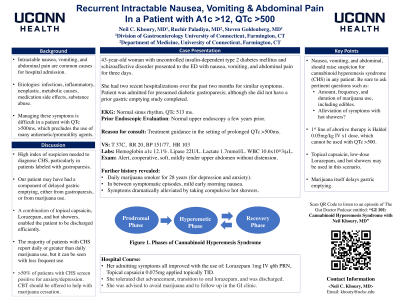Sunday Poster Session
Category: Stomach
P1386 - Recurrent Intractable Nausea, Vomiting, and Abdominal Pain in a Patient With A1c >12, QTc >500
Sunday, October 22, 2023
3:30 PM - 7:00 PM PT
Location: Exhibit Hall

Has Audio

Neil Khoury, MD
UConn Health
West Hartford, CT
Presenting Author(s)
Neil Khoury, MD1, Ruchir Paladiya, MBBS2, Steven Goldenberg, MD3
1UConn Health, West Hartford, CT; 2UConn Health, Hartford, CT; 3UConn Health, Farmington, CT
Introduction: Intractable nausea, vomiting, and abdominal pain are common causes for hospital admission. Etiologies include infectious, inflammatory, neoplastic, metabolic causes, side effects from medications, or substance abuse. Managing these symptoms is especially difficult when the patient has a QTc >500ms, which precludes the use of many antiemetic and promotility agents.
Case Description/Methods: 43-year-old female with insulin-dependent type 2 diabetes mellitus and schizoaffective disorder presented to the ED with nausea, vomiting, and abdominal pain for three days. Admitting diagnosis was presumed diabetic gastroparesis although she never completed a gastric emptying study. Consultation was requested for treatment guidance with her prolonged QT interval. She had two recent hospitalizations over the past two months for similar symptoms. She had been smoking marijuana daily for 28 years for depression and anxiety. In between symptomatic episodes, she would typically feel fine except for early morning nausea. Her symptoms were dramatically alleviated by taking compulsive hot showers. She had a normal upper endoscopy a few years prior. EKG NSR, QTc 513ms. Last hemoglobin a1c 12.1%. Lipase 22U/L. Lactate 1.7mmol/L. WBC 10.6x10^3/mL. On exam, she was afebrile, mildly hypertensive, mildly tachycardic, alert and cooperative, with a soft, mildly tender upper abdomen without distension. Her admitting symptoms all improved with the use of Lorazepam 1mg IV q6h PRN and topical capsaicin 0.075mg applied topically TID. She tolerated diet advancement, transition to oral lorazepam, and was discharged on the above medications. She was advised to avoid marijuana and to follow up in the GI clinic.
Discussion: Physicians should have a high index of suspicion to diagnose cannabinoid hyperemesis syndrome, particularly in patients labeled with gastroparesis. Our patient never had a gastric emptying study completed, yet clinicians assumed a diagnosis of gastroparesis. She may have had a component of delayed gastric emptying, either from gastroparesis, or from marijuana use. Of note, marijuana should be avoided prior to gastric emptying studies since it delays emptying. First line abortive therapy for CHS is Haloperidol, which could not be used for this patient due to her elevated QTc. Administration of topical capsaicin, Lorazepam, and hydrothermotherapy (hot showers) enabled the patient to be discharged efficiently. Most patients would benefit from cognitive behavioral therapy to help with continued marijuana cessation.
Disclosures:
Neil Khoury, MD1, Ruchir Paladiya, MBBS2, Steven Goldenberg, MD3. P1386 - Recurrent Intractable Nausea, Vomiting, and Abdominal Pain in a Patient With A1c >12, QTc >500, ACG 2023 Annual Scientific Meeting Abstracts. Vancouver, BC, Canada: American College of Gastroenterology.
1UConn Health, West Hartford, CT; 2UConn Health, Hartford, CT; 3UConn Health, Farmington, CT
Introduction: Intractable nausea, vomiting, and abdominal pain are common causes for hospital admission. Etiologies include infectious, inflammatory, neoplastic, metabolic causes, side effects from medications, or substance abuse. Managing these symptoms is especially difficult when the patient has a QTc >500ms, which precludes the use of many antiemetic and promotility agents.
Case Description/Methods: 43-year-old female with insulin-dependent type 2 diabetes mellitus and schizoaffective disorder presented to the ED with nausea, vomiting, and abdominal pain for three days. Admitting diagnosis was presumed diabetic gastroparesis although she never completed a gastric emptying study. Consultation was requested for treatment guidance with her prolonged QT interval. She had two recent hospitalizations over the past two months for similar symptoms. She had been smoking marijuana daily for 28 years for depression and anxiety. In between symptomatic episodes, she would typically feel fine except for early morning nausea. Her symptoms were dramatically alleviated by taking compulsive hot showers. She had a normal upper endoscopy a few years prior. EKG NSR, QTc 513ms. Last hemoglobin a1c 12.1%. Lipase 22U/L. Lactate 1.7mmol/L. WBC 10.6x10^3/mL. On exam, she was afebrile, mildly hypertensive, mildly tachycardic, alert and cooperative, with a soft, mildly tender upper abdomen without distension. Her admitting symptoms all improved with the use of Lorazepam 1mg IV q6h PRN and topical capsaicin 0.075mg applied topically TID. She tolerated diet advancement, transition to oral lorazepam, and was discharged on the above medications. She was advised to avoid marijuana and to follow up in the GI clinic.
Discussion: Physicians should have a high index of suspicion to diagnose cannabinoid hyperemesis syndrome, particularly in patients labeled with gastroparesis. Our patient never had a gastric emptying study completed, yet clinicians assumed a diagnosis of gastroparesis. She may have had a component of delayed gastric emptying, either from gastroparesis, or from marijuana use. Of note, marijuana should be avoided prior to gastric emptying studies since it delays emptying. First line abortive therapy for CHS is Haloperidol, which could not be used for this patient due to her elevated QTc. Administration of topical capsaicin, Lorazepam, and hydrothermotherapy (hot showers) enabled the patient to be discharged efficiently. Most patients would benefit from cognitive behavioral therapy to help with continued marijuana cessation.
Disclosures:
Neil Khoury indicated no relevant financial relationships.
Ruchir Paladiya indicated no relevant financial relationships.
Steven Goldenberg indicated no relevant financial relationships.
Neil Khoury, MD1, Ruchir Paladiya, MBBS2, Steven Goldenberg, MD3. P1386 - Recurrent Intractable Nausea, Vomiting, and Abdominal Pain in a Patient With A1c >12, QTc >500, ACG 2023 Annual Scientific Meeting Abstracts. Vancouver, BC, Canada: American College of Gastroenterology.
